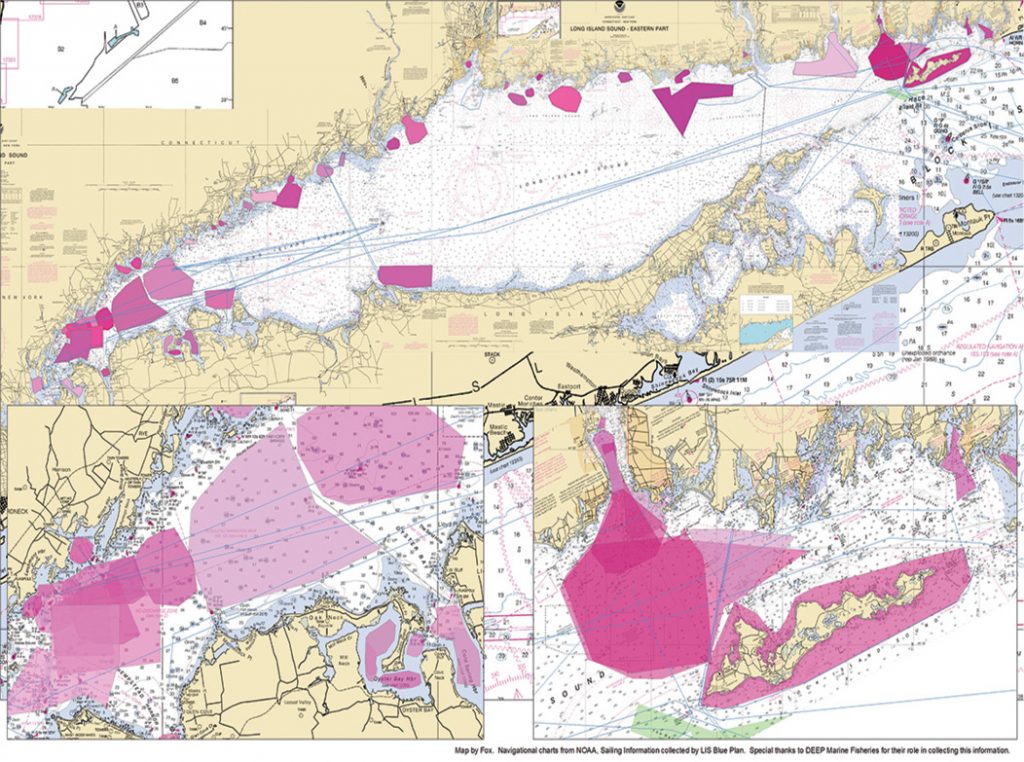By Nathan Frohling
As an avid sailor of Long Island Sound, I have spent countless times on the water with family and friends. The Sound is one of the joys in life that I want to be able to count on. I want it to remain as I know and love it. If you are a sailor – or however you enjoy Long Island Sound – I bet you too care about being able to count on the Sound to be there in the way you know and love it. That’s what the Long Island Sound Blue Plan is all about. Assuring the future of the Sound will be shaped to protect what we love – the recreation we cherish, the marine life we depend on, and the marine-based livelihoods that support us. At the end of March, the Connecticut Department of Energy and Environmental Protection and a 16-member Advisory Committee (of which I am a member) released the first draft Blue Plan for public comment.
Why do we need a Blue Plan? The Sound community got a wake-up call several years ago when an industrial liquid natural gas (LNG) facility was proposed that would have dramatically changed the Sound almost overnight. We realized there was no coordinated way to manage how we develop the Sound as a whole, no way to shape the cumulative result of all individual proposals and decisions for new uses, and no way to assure a collective vision for sustaining what we love. And our current permitting process for approving offshore projects does not proactively account for impacts to existing human uses such as sailing or fishing or significant ecological features such as cold-water corals and complex seafloor habitat. The LNG proposal helped us to see we needed a Blue Plan.
In 2015, based on informal grassroots efforts, in addition to marine spatial planning initiatives at the federal, regional and state levels, the Connecticut Legislature took an important step in enacting Public Act 15-66 to create a Blue Plan to protect the Sound’s natural resources and traditional human uses while allowing for compatible future use and development.
The Blue Plan is different than other Long Island Sound initiatives in that it’s all about places: the places that matter most to people and those that matter most to nature. This is the first time we have identified these and mapped them. The maps, in addition to being very interesting, are part of the protection process – they provide a foundation for guiding the policy. For the first time, we have a map of sailboat racing in the Sound and with it the means for assuring reasonable protection of these areas for sailing.

This map of sail racing areas is an example of an existing use to be recognized under the Long Island Sound Blue Plan. This information has never been collected before, and shows for the
So, how does it work? The Blue Plan does not create a new regulatory program. Instead it guides how the existing permitting and state decision-making process is to be carried out (in 10-feet or greater depths). In addition to facilitating the protection of important places of existing users and marine life, this also helps those with new projects because it provides greater clarity and transparency for how new uses can be compatible. The extensive information assembled by the Blue Plan process, including the many maps, provide new insight that all parties have access to. Everyone can see what the State of Connecticut is basing its decisions on. The Blue Plan policy also helps assure reasonability for all concerned and promotes communication between project proponents and existing users so that mutually acceptable outcomes can be found. For sailors like you and me, it means that the places we count on being open will have a better chance of staying open and for the Sound as a whole to remain the beautiful natural resource we know it to be.
The first draft of the Blue Plan is out. It is expected to be formally adopted into law next year. Right now we need the public to weigh in. The plan can be found at www.ct.gov/deep/lisblue and comments should be emailed before June 21 to BluePlanLIS@ct.gov. There will also be meetings (see sidebar) along the coast to facilitate understanding and comment on the Blue Plan through early June. Please email Christian Fox at christian.fox@tnc.org if you’d like to be added to the mailing list. ■
Nathan Frohling is the Director of Coastal and Marine Initiatives for the Nature Conservancy in Connecticut.
Upcoming Blue Plan meetings
May 9, 7:00 pm
Darien Library
Darien, CT
May 14, 7:00 pm
UConn Avery Point Academic Building
Groton, CT
May 23, 6:30 pm
Pavilion at Saybrook Point
Old Saybrook, CT
May 29, 7:00 pm
Town Hall Auditorium
Westport, CT
June 5, 7:00 pm
City Hall Auditorium
Milford, CT



